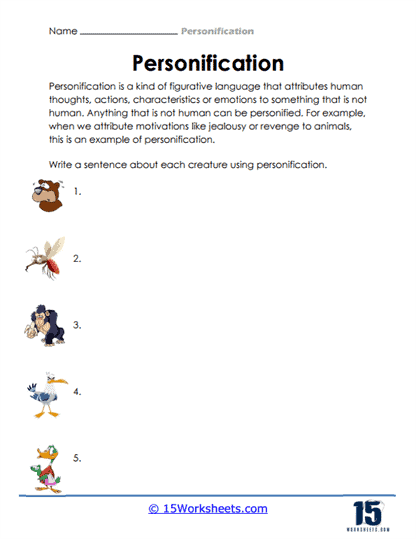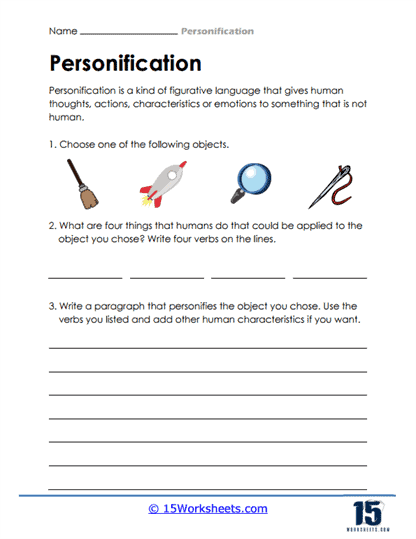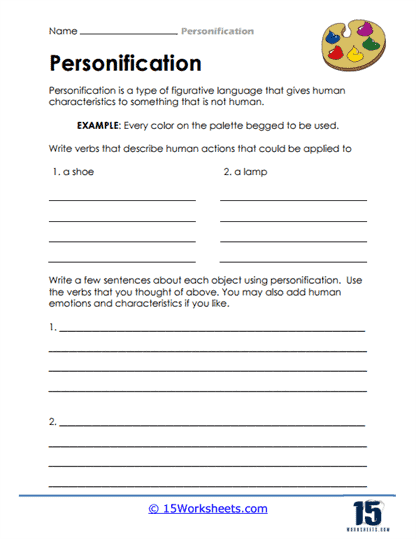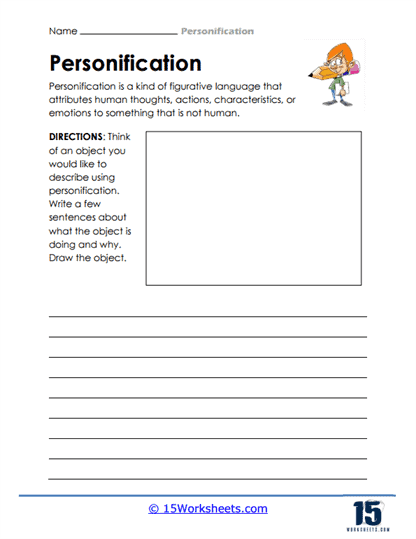Personification Worksheets
About These 15 Worksheets
These worksheets help you understand and practice using personification in language. Personification is a figure of speech in which human characteristics or behaviors are given to non-human things or abstract ideas. It’s like giving human qualities to something that is not human.
To explain personification, let’s look at an example – Imagine a sentence that says, “The flowers danced in the breeze.” This sentence uses personification because it attributes the human action of dancing to flowers. Flowers cannot actually dance, but the use of personification adds a vivid and imaginative quality to the description.
Personification worksheets provide exercises and activities that help you recognize, identify, and create personification in sentences or descriptions. These worksheets often contain examples of sentences or phrases, and you have to identify the objects or ideas that are given human qualities.
By working on personification worksheets, you can:
Identify Personification – Personification worksheets help you develop the skill of recognizing personification in language. By reading sentences or passages, you learn to identify phrases or expressions that give human qualities to non-human things or abstract ideas. This skill allows you to appreciate the creative and imaginative use of language in bringing inanimate objects or concepts to life.
Understand Figurative Language – Personification worksheets allow you to explore how figurative language works. You learn how personification adds depth and emotion to descriptions by making them more relatable and engaging. By understanding personification, you gain insight into the power of language to convey meaning in unexpected and imaginative ways.
Enhance Descriptive Writing – By learning about personification, you enhance your own descriptive writing skills. Personification allows you to make your writing more expressive and captivating. By practicing personification through worksheets, you develop the ability to incorporate this figure of speech into your own writing, adding a creative and imaginative touch to your storytelling.
Foster Empathy and Connection – Personification helps foster empathy and connection between readers and the objects or ideas being personified. By attributing human qualities to non-human things, readers can relate to them on a deeper level. Personification allows readers to form emotional connections with the text, enhancing their understanding and appreciation of the subject matter.
Appreciate Literary Techniques – Personification worksheets foster an appreciation for the artistic techniques used in literature. Personification showcases the creativity and inventiveness of writers in giving life and personality to inanimate objects or abstract concepts. By exploring personification, you develop a deeper understanding and appreciation for the beauty and artistry of language.
Why Do Authors Use Personification In Their Work?
Authors use personification in their work for several reasons:
Adding Vividness and Imagery – Personification brings inanimate objects or abstract ideas to life by attributing human qualities to them. By giving human characteristics or behaviors to non-human things, authors create vivid and imaginative descriptions that engage the reader’s senses. Personification adds a layer of visual and sensory imagery, making the writing more memorable and evocative.
Creating Emotional Connection – Personification helps create an emotional connection between the reader and the objects or ideas being personified. By attributing human qualities, readers can relate to and empathize with them on a deeper level. Personification can evoke emotions and foster a sense of familiarity or understanding, making the writing more impactful and emotionally resonant.
Enhancing Descriptions and Storytelling – Personification adds depth and richness to descriptions and storytelling. By ascribing human characteristics to non-human elements, authors can provide unique perspectives, insights, or commentary on the subject matter. Personification makes the writing more dynamic and engaging, allowing readers to see the world from a fresh and imaginative viewpoint.
Conveying Abstract Concepts or Ideas – Personification helps make abstract concepts or ideas more concrete and relatable. By giving them human qualities, authors can make complex or intangible concepts more accessible to readers. Personification can make philosophical or metaphorical ideas easier to grasp by presenting them in familiar and human terms.
Creating Symbolism and Allegory – Personification can be used to create symbolism or allegory in literature. By assigning human characteristics to objects or ideas, authors can convey deeper meanings or represent larger concepts. For example, personifying death as a hooded figure can represent mortality and evoke specific cultural or literary associations.
Adding Literary Flair and Creativity – Personification allows authors to showcase their creativity and linguistic skills. By personifying objects or ideas, authors demonstrate their inventiveness in finding new and imaginative ways to express themselves. Personification adds a touch of literary flair, making the writing more interesting and distinct.















